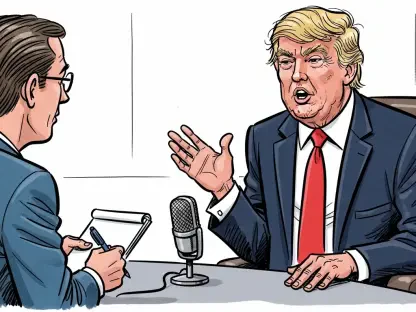In a world where global trade alliances are shifting rapidly, the relationship between Canada and China stands at a critical juncture, with economic pressures mounting and security concerns lingering. A recent meeting at the Asia-Pacific Economic Summit in South Korea between Canadian Prime Minister Mark Carney and Chinese President Xi Jinping has sparked renewed interest, raising a pressing question: can these two nations navigate their complex history to build a stable partnership? This roundup gathers diverse perspectives from industry leaders, policy analysts, and trade experts to explore the challenges, opportunities, and cautious optimism surrounding this evolving dynamic. The aim is to provide a comprehensive look at whether economic pragmatism can bridge the gap created by past tensions and ongoing mistrust.
Diving into a Complex Bilateral Relationship
Economic Drivers Pushing for Collaboration
Insights from trade analysts highlight a shared urgency for Canada and China to mend economic ties amid global uncertainties. With U.S. tariffs looming as a threat to both nations, there’s a growing consensus that collaboration could offer a buffer against external pressures. Reports indicate that Canada’s ambition to double non-U.S. exports over the next decade aligns with China’s interest in diversifying its trade partners, creating a mutual incentive for dialogue. However, recent trade disputes, such as Canada’s 100% tariff on Chinese electric vehicles and China’s retaliatory measures on canola and seafood, underscore the fragility of this economic push.
Another angle from business councils emphasizes the potential benefits of focusing on specific sectors like energy and technology. These areas, often cited by Chinese leadership as priorities for expanded cooperation, could serve as testing grounds for rebuilding trust. Yet, skepticism persists among some economists who argue that unresolved tariffs and market access barriers might hinder progress. The balance between economic gain and lingering grievances remains a point of contention in expert discussions.
A third perspective from international trade forums suggests that global trends, including the erosion of rules-based trade systems, might force both nations to adapt their strategies. This shift could open doors for targeted agreements, though opinions differ on whether such partnerships can withstand the weight of historical friction. The economic narrative, while promising, is clearly tempered by caution across various analyses.
Security Concerns Looming Over Trust
Turning to security, policy experts widely agree that Canada’s perception of China as a foreign threat continues to cast a shadow over diplomatic efforts. Concerns about China’s ambitions in the Arctic and potential interference in Canadian affairs are frequently cited as non-negotiable issues. Analysts from security think tanks stress that while economic engagement is vital, safeguarding national sovereignty must remain a priority for Canadian policymakers.
A contrasting viewpoint from diplomatic circles argues for a balanced approach, suggesting that dialogue at the highest levels can help mitigate misunderstandings. Some advisors note that the recent summit signals a willingness to address security concerns through structured communication, though they warn against over-optimism. The challenge lies in ensuring that economic ties do not compromise critical national interests, a concern echoed across multiple analyses.
Additionally, regional security specialists point to the broader geopolitical context, where Canada must navigate its alliances with Western partners while engaging with China. This delicate balancing act is seen as a potential stumbling block, with differing opinions on how much risk Canada should accept in pursuit of economic benefits. The consensus leans toward vigilance, with experts urging a cautious yet open stance in negotiations.
Opportunities in a Shifting Global Trade Landscape
Global trade dynamics offer a glimmer of hope, according to insights from economic strategists. The decline of traditional trade frameworks has pushed both Canada and China to explore alternative partnerships, with the Asia-Pacific region emerging as a key focus. Sectors like renewable energy and advanced technology are often highlighted as areas ripe for collaboration, with the potential to benefit both economies if barriers are addressed.
However, trade consultants caution that these opportunities come with inherent risks, particularly when security misgivings are factored in. Some argue that without clear agreements on intellectual property and market fairness, partnerships in high-stakes industries could become flashpoints for conflict. This divergence in opinion reflects the uncertainty surrounding whether shared goals can override past disputes in a meaningful way.
A further perspective from industry roundtables emphasizes the need for small, incremental steps to test the waters of cooperation. Pilot projects in less contentious sectors could build confidence, though opinions vary on whether such measures are sufficient to address deeper systemic issues. The overarching theme from these discussions is that while opportunities exist, their success hinges on both nations’ ability to align on fundamental principles.
Leadership and the Nuances of Diplomatic Thaw
Examining leadership dynamics, political analysts note that the personal stakes for both Mark Carney and Xi Jinping are significant in this renewed dialogue. Public statements from both leaders about stability and mutual opportunity have been interpreted as a genuine intent to reset relations. However, some observers argue that these remarks may serve more as symbolic gestures than concrete commitments, pointing to past unsuccessful attempts at reconciliation.
A differing view from diplomatic historians suggests that current leadership styles could influence the trajectory of negotiations. Carney’s pragmatic approach and Xi’s focus on long-term stability are seen as complementary by some, though others remain skeptical about whether these traits can translate into actionable outcomes. The debate centers on whether this summit represents a substantive shift or merely a diplomatic formality.
Lastly, commentary from international relations scholars adds depth by questioning the sustainability of this cautious optimism. While the meeting has been hailed as a step forward, there’s a split in opinion on whether domestic political pressures in both countries might derail progress. This diversity of thought underscores the complexity of leadership roles in navigating such a multifaceted relationship.
Key Takeaways from Varied Perspectives
Synthesizing these insights, several critical themes emerge from the roundup of expert opinions. Economic incentives, such as the shared challenge of U.S. tariffs and the potential for sector-specific cooperation, are driving forces behind the push for better Canada-China ties. Yet, security dilemmas, particularly Canada’s concerns over national sovereignty and China’s regional ambitions, remain formidable hurdles, with experts advocating for a guarded approach.
Another key point of agreement is the impact of global trade shifts, which are reshaping strategies and creating openings for partnership, though opinions differ on the feasibility of capitalizing on these trends. Leadership dynamics also play a pivotal role, with some analysts viewing the recent summit as a promising start, while others see it as a largely symbolic effort. This spectrum of views highlights the nuanced nature of the relationship, balancing hope with realism.
Finally, practical steps suggested by contributors include prioritizing targeted trade agreements to resolve specific disputes and establishing joint task forces for ongoing dialogue. Staying informed through policy updates and engaging with analyses from trade and security forums is also recommended for those tracking this evolving dynamic. These actionable insights provide a roadmap for understanding and navigating the next phases of this bilateral relationship.
Reflecting on a Tentative Step Forward
Looking back, the dialogue between Canada and China at the Asia-Pacific Economic Summit marked a significant moment of engagement after years of strained relations. The diverse perspectives gathered revealed a shared recognition of economic imperatives, tempered by persistent security challenges that shaped the cautious tone of discussions. This roundup captured the spectrum of hope and skepticism that defined expert analyses at the time.
Moving forward, actionable considerations include fostering smaller, confidence-building initiatives in trade sectors with less friction, such as agricultural exports or green energy projects. Establishing regular high-level meetings to address security concerns transparently could also pave the way for trust. Additionally, stakeholders are encouraged to monitor regional trade agreements in the Asia-Pacific for their potential impact on this bilateral dynamic, ensuring that future strategies remain adaptive and informed by global shifts.









